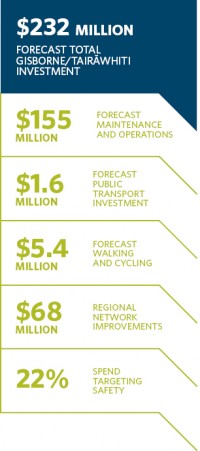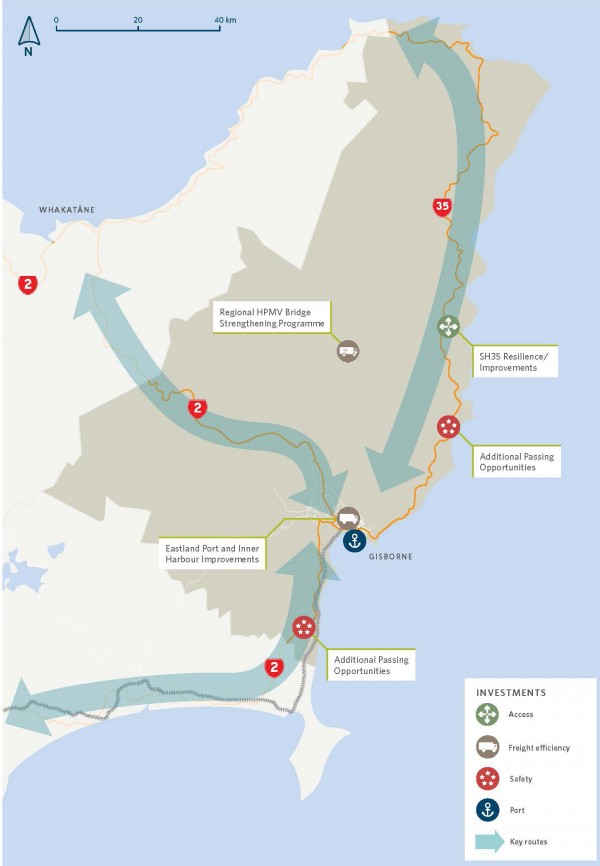
For the population of Gisborne/Tairāwhiti, having a resilient transport network is crucial. The region’s relative isolation means it relies on the state highway network and local roads to connect its communities, to get goods from farm gates and forests to markets, and to support growth in tourism.
Reliable and efficient transport connections remain the greatest challenge for the region with weather events and unstable ground conditions resulting in frequent slips, road closures and higher maintenance costs. Closures have a significant social and economic impact on the region’s rural communities. Connections to neighbouring regions are limited. Both SH2 northwest to the Bay of Plenty and SH35 to the north are vulnerable to closures, and the detours are long when there is any disruption.
The Tairāwhiti Regional Economic Action Plan, He Huarahi Hei Whai Oranga, identifies a number of transport objectives to support improved economic and social outcomes for the region:
With the expansion of forestry harvesting in the region, the upgrading of rural roads remains a priority to cater for the increase in freight traffic. High productivity motor vehicles (HPMVs) are a growing proportion of traffic on SH2 south of Gisborne, but full HPMV access is restricted on many roads.
With Gisborne’s lack of viable alternative transport networks, road closures are costly for the region.
Investment during this NLTP is focused on improving the resilience of the road network. This work will include a range of improvements to areas with recurring dropouts via a package of stabilisation work including the East Coast Road Bluffs and Waihau Bluffs slopes; SH35 Te Hue Road, Puketiti Hill, Gudgeons Hill and Mangahauini wall north; and Kopuaroa Road and Kopuaroa Hill.
Other projects to improve resilience are:
An additional package of emergency works funding will repair the damage to the road network caused during recent flooding.
A significant investment will be made to improve local roads and support the region’s economic development.
This work includes packages for HPMV strengthening on SH2 Gisborne to Napier and Gisborne to Ōpōtiki routes, and 50 MAX upgrades at key locations on local roads to support local industry.
Other projects include:
Safety on the region’s transport network remains a concern. The region has a high proportion of deaths and serious injuries. The main cause of crashes are drink driving, people not wearing seatbelts and crashes involving cyclists in high speed areas. A high proportion of drivers are unlicensed.
This NLTP will invest more than $1 million on a number of initiatives to make the region’s roads safer:
Funding will also support better access to driver licensing facilities.
Freight trucks present a particular risk to children in rural areas. An investigation will be funded to look at improving rural school bus stops, installing safe school speeds signs and variable speed signage along SH2 and SH35.
Tourism is making an increasing contribution to the region’s economy, with the region experiencing a nine percent growth in tourist numbers between 2016 and 2017.
To make it safer and easier for visitors to travel throughout the region, this NLTP will invest in:
Travel in Gisborne city is dominated by private vehicle trips, accounting for almost 90 percent of work-related trips in 2013. The city has limited public transport options, and the latest statistics show the number of people walking or cycling is declining.
A total of $1.6 million will be spent on public transport services this NLTP period. This will fund Gisborne’s current bus service but also look at service improvements to encourage more people to leave their cars at home and use public transport. A review of the rural travel fund will look for opportunities to give rural communities along SH2 and SH35 better access to jobs, health and education facilities, and to events.
